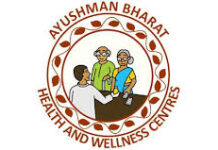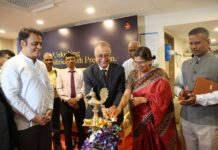Uploaded on: 07 April 2020
Updated on: 08 April 2020
*Dr Varsha Narayanan
Overview
COVID-19 (Coronavirus Disease), caused by the novel Coronavirus designated 2019-nCoV (and thereafter called SARS-CoV-2), first seen in Wuhan, China in December 2019, has now swept across most countries and surfaced as one of the major pandemics the world has seen.1 India too has been impacted with the first few cases emerging in end January-early February 2020 and the disease gaining a foothold across the country by March 2020.
COVID has a Reproductive number (R0) of around 2.3, and is transmitted by droplets emitted from infected individuals through direct contact or close proximity (about 1 meter) and infected surfaces (on which virus can remain for around up to 12 hours or longer).2,3 From the time of getting infected, COVID symptoms can take from 2 days to 2 weeks to manifest. Symptoms include sore throat, cough and fever which may be sometimes accompanied by nasal congestion, running nose, loss of smell, sneezing, headache, fatigue, body pain and rarely vomiting or diarrhea. The virus can spread to the lower respiratory tract and lungs in about 4-5 days causing breathlessness due to bronchitis and pneumonia. Death occurs from ARDS (Acute Respiratory Distress Syndrome) or sepsis and multi-organ failure.4
Almost 80% of people have mild symptoms. The overall global mortality rate from COVID-19 is around 2-3% as has been seen in India as well. Risk of serious disease, complications, and death is higher in patients >60 years and those suffering from other underlying medical illnesses like Diabetes, Hypertension, Cancers, and diseases of the Airway, Heart, Kidney, Liver or Immune system.5
Currently there are no specific drugs validated by large randomized clinical trials for COVID-19, but based on small studies, case reports and anecdotal evidence, Hydroxychloroquine and its combination with Azithromycin, and antiretrovirals Lopinavir-Ritonavir are being selectively used with ADR monitoring, along with symptomatic therapy in India.6,7 The global SOLIDARITY trial may shed more light and conviction on these therapies in the near future.8 COVID RNA vaccine trials are underway with the hope of its availability by early 2021.9
Tackling COVID-19 in India
India represents one of the most unique countries in terms of diversity and disparity. While instituting uniform COVID-19 measures and policies, an array of occupational, cultural, educational and economic issues presents themselves. There are also challenges related to types of housing and living, as well as distribution and availability of health care facilities. The approach befitting a country like India would be TIP – Testing and Tracing contacts, Isolation of confirmed and suspected cases as well as high risk contacts, and Precautions and Preventive measures for the population.
Testing for COVID-19 and Tracing Contacts
Testing criteria in India include symptomatic patients (fever with cough or breathlessness) with travel history (in past 14-21 days), or contact history with symptomatic travelers or high suspicion/confirmed COVID cases. Asymptomatic persons in these categories undergo minimum 14-day quarantine to observe for symptoms. In addition, testing asymptomatic people living in the same household as a COVID positive case (high risk contacts) is also an important part of the criteria, as these people carry high risk of contracting and transmitting infection.10 Testing this last group is challenging in urban slums and clustered residential areas with several sharing a room, common balconies, toilets and water filling sources. In such areas more robust testing of possible COVID contacts becomes very important to limit the rapid spread and spike in cases which can make these areas hotspots. In addition, meticulously tracing and quarantining of contacts though of high importance to prevent and contain outbreaks, can prove to be a major task due to close proximity of living, mixing and working in these areas, thereby necessitating sealing and cordoning off huge population clusters.
Other groups to be tested include hospitalized patients with severe acute respiratory symptoms or influenza like illness and pneumonia, symptomatic Health Care Workers (HCWs) handling COVID positive patients and asymptomatic HCWs if they have handled a COVID positive case without adequate protection. Contact tracing for positive HCWs can be a daunting task considering patient volumes in India, resulting in decisions to temporarily close many OPDs and non-emergency consulting clinics. However, this can establish and propagate E-consulting and Tele-medicine, that can play a very positive role in the future of health care in the 2020 decade.11
More and more testing and tracing contacts is central to tackling and containing COVID-19 in India. Currently testing in suspected cases is done with nasopharyngeal and/or oropharyngeal swab samples for presence of the nCoV-2019 RNA by RTPCR (Real-time Polymerase Chain Reaction).12 Domestic production and approval of testing kits which can reduce testing time to under 2.5-3 hours has been a major step. (Rapid 5-minute tests launched globally will be on their way in the near future). Expanding testing centers to involve both government and private hospitals and laboratories has been an encouraging move. Currently there are more than 125 government testing centers spread across India with at least one in most states, and more in pipeline. Over 50 private hospitals and labs have stepped in with more than 15,000 country wide collection centers, with introduction testing kiosks and even drive-through testing recently. However, shortage of testing kits and handling gear, hurdles in home sample collection, high test cost and differential directives have been some of the challenges faced by private labs in contributing to greatly scaling up testing, which is the need of the hour.
The rapid blood serological testing for antibodies to 2019-nCoV in blood has been now developed and approved in India, which can give results within 15-30 minutes.13 This can aid as a quick screening test (to be followed by confirmatory swab test) in hotspots, or in dense clusters or interiors (where migrant population from cities has returned) when there are suspected/known positive cases. In combination with the RTPCR swab test, the rapid antibody test can help detect active symptomatic cases, asymptomatic carriers, and those with immunity developed to the virus.
Till domestic production of testing kits and gear scales up, the challenging option of importing these in bulk is being taken up.
Chest CT scan is being recommended as an important diagnostic tool for COVID-19 due to high sensitivity, however feasibility, availability and cost remain important limitations for its generalized usage in our country.14
Isolation of Cases
There are two types of Isolation which are important. Firstly, isolation by quarantining of patients who have risk of exposure and being infected with COVID-19, like people recently returned from travel, those exposed to symptomatic people with recent travel history, and those possibly exposed to known positive COVID cases. Such people are either isolated in their home/home room (with intimation of the housing society administration) or in assigned approved quarantining facilities. These group of people are under observation for a minimum period of 14 days (extendable in specific situations) and swab tested when symptomatic.
The second type of isolation is of those who have tested positive for COVID-19. All such patients were being hospitalized in India in isolation wards. There are now many government hospitals and apex institutes, along with private hospitals also being commissioned recently, which have established COVID Isolation wards and ICUs. To prevent overwhelming and overloading of healthcare workers and facilities, a triple level of isolation will be seen coming into play, with patients having mild symptoms and no risk factors or pre-existing medical illness, isolated in COVID-Care Centers, (self-care/basic care repurposed stay centers like hostels, lodges, stadia, guest houses, etc.) until their symptoms resolve and laboratory tests for COVID-19 virus are negative.10
Moderate and Severe cases having breathlessness (increased RR with SpO2<94% and evidence of Pneumonia on imaging, at presentation) are to be immediately taken up for admission to COVID isolation wards in Dedicated COVID Health Centers or Hospital blocks/Hospitals with oxygen and life support/ventilator availability. Severe high-risk cases with SpO2<90% or RR≥30, or evidence of ARDS/septic shock, should be admitted in designated COVID-only hospitals/hospital blocks with ICU. Patients can be discharged once they test COVID negative, and are asymptomatic and stable.
During such segregation it is of utmost importance that suspect cases being tested and confirmed cases being taken up for medical treatment, are kept well separated at all times. Going further Isolation at home/home rooms and home care should be considered where feasible for mild cases to ease load off the HCWs and facilities as seen in some other countries.15
Such segregation can also help in reducing exposure and infection of HCWs due to lack of adequate Personal Protective Equipment (PPE), and help several hospitals and health care centers cater effectively to other medical care which should not be compromised during the ongoing COVID pandemic. Another appreciable move has been free of cost testing and treatment for COVID-19 for Ayushman Bharat beneficiaries at private laboratories and empaneled hospitals, by the National Health Authority (NHA).16
Precautions and Preventive measures
Precautionary measures by and for the general population which encompass hygiene, self-discipline, adherence-compliance to directives, awareness and understanding of the disease, and display of patience, rationality and tolerance, form the base on which any kind of management and containment strategy can be built and implemented for a pandemic such as COVID-19.
Actions like restricting flights, sealing airports and borders, closing all public places and institutions, limiting public transport, imposing lockdown, and discontinuing all non-essential and non-emergency services are some of the commendable and timely measures taken in India before the onset of any significant COVID-19 community spread. Maintenance of essential services, food and medicine supplies and emergency health services in India during the period of lockdown, in a streamlined manner has also been internationally applauded. In addition, there have been continued and immense efforts in educating, guiding and updating the public about frequent hand washing, covering nose/mouth while sneezing/coughing, avoiding facial touching, practicing social distancing, avoiding crowds and staying home, appropriate usage of masks and sanitizers, and discarding of used tissues etc. There have also been repeated mandates put out for 14-day self quarantining post travel.10
The most important point is for the people to follow and adhere to these advisories and recommendations along with respecting, allowing and ensuring the smooth functioning and duty execution of all HCWs and municipal staff. The latter includes not only in hospitals, health centers and labs but also in their premises, residential complexes and locality during sanitization activities, contact tracing, quarantining implementation and test sample collection. As discussed, social distancing is a luxury and privilege in low-income urban cluster-housing areas (with some clusters having a density of >1 lakh/sq km), while educational and economic barriers along with socio-cultural factors may impede certain hygienic and health measures, requiring imposition of extra restrictions and administrative measures. There is some initial evidence to suggest a protective effect of BCG vaccine, which is part of the immunization schedule in India, unlike the western world. This may be due to its immune stimulatory effect thereby enhancing anti-viral protection, however more conclusive research is still awaited.17
India is a country of diverse beliefs, cultures, systems and practices. With digitalization and widespread access to social media, a gamut of information is available, shared and spread in a short period which can not only adversely impact positive efforts, but also lead to misplaced fear, panic and undesirable social repercussions. Therefore repeatedly, the importance of social responsibility and refraining from spreading medically and scientifically unvalidated information, needs to be emphasized. The Ministry of Health and Family Welfare (MoHFW) of India along with the Indian Council of Medical Research (ICMR), has one of the most updated online sites with all information, FAQs, advisories and recommendations in place for COVID-19. In addition, the AarogyaSetu app, launched for installation in smart phones aids calculation of the risk of COVID based on parameters of positive cases in the vicinity, enabling taking necessary timely steps for assessing risk of spread of COVID-19 infection, and ensuring isolation where required.18
Protection and Precautions for HCWs is a paramount and concerning factor in the fight against COVID-19. Ensuring availability of PPEs for all HCWs and N-95/Triple layer masks (for both patients and HCWs) is currently a pertinent challenge being addressed. Consideration and use of Hydroxychloroquine prophylaxis in HCWs and household members handling COVID patients has been recently approved in India.19 Twice daily temperature and symptom self-monitoring has also been advised for frontline HCWs along with meticulous personal hygiene and protective gear.20
Conclusion
COVID-19 in India is being tackled with, and further requires a combination of meticulous and organized testing and contact tracing, quarantining of at-risk and possibly exposed/suspect cases, multilevel isolation and management of COVID positive patients, and above all precautions, compliance and solidarity of India’s people. India, with its set of diversity in cultures, systems, healthcare access and economic disparities, presents unique challenges and demands. Very encouraging and effective containment actions have already been taken, along with systematic advisories and recommendations being put in place. Further enhancing health care facilities, protective gear and testing kits, as well as streamlining patient management would be focus areas for tackling this pandemic. Preventing outbreaks especially in cluster living areas and existing/potential hotspots would be crucial to prevent large scale community spread. Maintaining the trust, compliance and cooperation of the people along with preventing spread of panic and misinformation are winning factors. The role of all Doctors and HCWs whether frontline or not, is of great importance in imparting right awareness and guidance on COVID-19, as well as maintaining community health and management of medical illnesses by effectively using digital platforms, e-consulting and telemedicine.
Disclaimer: Information is dated 7th April 2020
References
- Coronavirus: World Health Organization 2020. https://www.who.int/health-topics/coronavirus#tab=tab_1
- Kucharski AJ, Russel TW, Diamond C, Liu Y, Edmunds J, Funk S et al. Early dynamics of transmission and control of COVID-19: a mathematical modelling study. Lancet Infect Dis 2020; published online March 11. https://www.thelancet.com/journals/laninf/article/PIIS1473-3099(20)30144-4/fulltext
- Zhang S, Diao M, Yu W, Pei L, Lin Z, Chen D. Estimation of the reproductive number of novel coronavirus (COVID-19) and the probable outbreak size on the Diamond Princess cruise ship: A data-driven analysis. Int J Infect Dis.2020 Feb 22;93:201-204. https://www.ncbi.nlm.nih.gov/pubmed/32097725
- Wu C, Chen X, Cai Y, Xia J, Zhou X, Xu S et al.. Risk Factors Associated with Acute Respiratory Distress Syndrome and Death in Patients with Coronavirus Disease 2019 Pneumonia in Wuhan, China. JAMA Intern Med.2020 Mar 13. https://www.ncbi.nlm.nih.gov/pubmed/32167524
- Ruan S. Likelihood of survival of Coronavirus disease 2019. The Lancet, March 30, 2020. https://www.thelancet.com/journals/laninf/article/PIIS1473-3099(20)30257-7/fulltext
- Gautret P, Lagier JC, Parola P, Hoang VT, Meddeb L, Maihe M et al. Hydroxychloroquine and azithromycin as a treatment of COVID-19: results of an open-label non-randomized clinical trial. March 20, 2020. https://www.sciencedirect.com/science/article/pii/S0924857920300996
- Bhatnagar T, Murhekar MV, Soneja M, Gupta N, Giri S, Wig N et al. Lopinavir/ritonavir combination therapy amongst symptomatic coronavirus disease 2019 patients in India: Protocol for restricted public health emergency use. Indian Journal of Medical Research, March 2020 online. http://www.ijmr.org.in/preprintarticle.asp?id=280484;type=0
- World Health Organization SOLIDARITY Trial 2020. https://www.who.int/emergencies/diseases/novel-coronavirus-2019/global-research-on-novel-coronavirus-2019-ncov/solidarity-clinical-trial-for-covid-19-treatments
- Yamey G, Schaferhoff M, Hatchett R, Pate M, Zhao F, McDade KK, et al. Ensuring Global access to COVID-19 vaccines. The Lancet, published March 31, 2020. https://www.thelancet.com/journals/lancet/article/PIIS0140-6736(20)30763-7/fulltext
- Ministry of Health and Family Welfare and Indian Council of Medical Research COVID-2019 guidelines and advisories. https://www.mohfw.gov.in/
- Narayanan V. Enhancing Health Care in India – What to Expect in the Coming Decade? The Indian Practitioner q Vol.73 No.1. January 2020. http://articles.theindianpractitioner.com/index.php/tip/article/view/911
- Accelerated Emergency Use Authorization (EUA) Summary COVID-19 RT-PCR Test. 2020. https://www.fda.gov/media/136151/download
- Ministry of Health and Family Welfare and Indian Council of Medical Research COVID-2019 https://www.mohfw.gov.in/pdf/Advisory&StrategyforUseofRapidAntibodyBasedBloodTest.pdf
- Fang Y, Zhang H, Xie J, Lin M, Ying L, Pang P et al. Sensitivity of Chest CT for COVID-19: Comparison to RT-PCR. RSNA Radiology Feb 19, 2020. https://pubs.rsna.org/doi/10.1148/radiol.2020200432
- Home care for patients with COVID-19 presenting with mild symptoms and management of their contacts. WHO Interim guidance Feb 2020. https://www.who.int/publications-detail/home-care-for-patients-with-suspected-novel-coronavirus-(ncov)-infection-presenting-with-mild-symptoms-and-management-of-contacts
- COVID-19: Testing, treatment free for Ayushman Bharat beneficiaries at private labs, empaneled hospitals. Economic Times, India 4th April 2020. https://economictimes.indiatimes.com/news/politics-and-nation/covid-19-testing-treatment-free-for-ayushman-bharat-beneficiaries-at-pvt-labs-empanelled-hospitals/articleshow/74986228.cms
- Narayan VM, Hegarty P, Giannarini G, Bangs R, Chisolm S, Kamat AM. Beyond Bladder Cancer: Bacillus Calmette-Guérin (BCG) Vaccination Revisited as a Strategy to Reduce COVID-19 Related Adverse Events in High Risk Health Care Workers and the Elderly. Urotoday, 2nd April 2020. https://www.urotoday.com/library-resources/bladder-cancer/120412-beyond-bladder-cancer-bacillus-calmette-guerin-bcg-vaccination-revisited-as-a-strategy-to-reduce-covid-19-hospitalization-in-the-elderly.html
- AarogyaSetu Mobile app, Government of India 2020. https://www.mygov.in/aarogya-setu-app/
- Advisory on the use of Hydroxychloroquine as prophylaxis for SARS-CoV-2 infection. National Task Force, ICMR. 2020. https://www.mohfw.gov.in/pdf/AdvisoryontheuseofHydroxychloroquinasprophylaxisforSARSCoV2infection.pdf
- Interim U.S. Guidance for Risk Assessment and Public Health Management of Healthcare Personnel with Potential Exposure in a Healthcare Setting to Patients with Coronavirus Disease (COVID-19). Centers for Disease Control and Prevention. CDC March 7, 2020. https://www.cdc.gov/coronavirus/2019-ncov/hcp/guidance-risk-assesment-hcp.html
Health and Pharmaceutical Consultant, Dr Varsha’s Health Solutions,
Andheri West, Mumbai.Email-info@drvarsha.com
























